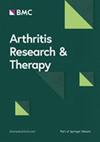滑膜成纤维细胞产生的小细胞外囊泡含有不同的 miRNA,是骨关节炎中软骨细胞损伤的原因之一
IF 4.9
2区 医学
Q1 Medicine
引用次数: 0
摘要
滑膜成纤维细胞(SF)产生的小细胞外囊泡(sEV)是调节骨关节炎(OA)软骨侵蚀的一种新型分子机制。然而,目前尚未使用与疾病相关的细胞进行全面评估。本研究的目的是从 OA SF 中分离出 sEV 并对其进行表征,研究它们调节与疾病相关的 OA 软骨细胞效应反应的能力。研究人员对 sEV 和亲代 OA SF 细胞中的微 (mi) RNA 特征进行了分析。SF和软骨细胞分别从OA滑膜和软骨中分离出来(n = 9)。sEV通过超速离心从OA SF(± IL-1β)条件培养基中分离出来,并使用扫描电子显微镜(SEM)和透射电子显微镜(TEM)进行表征。使用 qPCR、ELISA 和硫酸化糖胺聚糖检测法(sGAG)评估了 sEV 对 OA 软骨细胞和软骨效应因子反应的调控。RNA 测序用于确定从 OA SF 分离的 sEV 中的 miRNA 特征。OA SF 衍生的 sEV 很容易被 OA 软骨细胞吸收,观察到分解基因 MMP 13 的表达增加(p < 0.01),合成基因 aggrecan 和 COL2A1 的表达减少(p < 0.01)。用来源于 IL-1β 刺激的 OA SF 的 sEV 处理可显著降低 aggrecan 和 COL2A1 的表达(p < 0.001),增加 SOX 9 基因的表达(p < 0.05)。用未经刺激或经 IL-1β 处理的 OA SF 的 sEV 培养 OA 软骨细胞,会导致 IL-6、IL-8 和 MMP-3 的分泌明显增加(p < 0.01)。用 SF 的 sEV(± IL-1β)培养的软骨外植体释放的 sGAG 显著增加(p < 0.01)。与亲代细胞相比,最近发现的破骨细胞生成调节因子 miR182 以及 miR4472-2、miR1302-3、miR6720、miR6087 和 miR4532 在 sEV 中富集,p < 0.01。未受刺激或受 IL-1β 刺激的 SF sEV 中的特征相似。OA SF sEV 可调节软骨细胞的炎症和重塑反应。与亲代细胞相比,OA SF sEV 具有独特的特征,这些特征不会随着 IL-1β 的刺激而改变。这项研究深入揭示了 OA 关节内的新型调控机制,可为未来的靶向治疗提供依据。本文章由计算机程序翻译,如有差异,请以英文原文为准。
Small extracellular vesicles derived from synovial fibroblasts contain distinct miRNA profiles and contribute to chondrocyte damage in osteoarthritis
Small extracellular vesicles (sEV) derived from synovial fibroblasts (SF) represent a novel molecular mechanism regulating cartilage erosion in osteoarthritis (OA). However, a comprehensive evaluation using disease relevant cells has not been undertaken. The aim of this study was to isolate and characterise sEV from OA SF and to look at their ability to regulate OA chondrocyte effector responses relevant to disease. Profiling of micro (mi) RNA signatures in sEV and parental OA SF cells was performed. SF and chondrocytes were isolated from OA synovial membrane and cartilage respectively (n = 9). sEV were isolated from OA SF (± IL-1β) conditioned media by ultracentrifugation and characterised using scanning electron microscopy (SEM) and transmission electron microscopy (TEM). Particle size was confirmed by nanoparticle tracking analysis (NTA). sEV regulation of OA chondrocyte and cartilage effector response was evaluated using qPCR, ELISA and sulphated glycosaminoglycan assay (sGAG). RNA-sequencing was used to establish miRNA signatures in isolated sEV from OA SF. OA SF derived sEV were readily taken up by OA chondrocytes, with increased expression of the catabolic gene MMP 13 (p < 0.01) and decreased expression of the anabolic genes aggrecan and COL2A1 (p < 0.01) observed. Treatment with sEV derived from IL-1β stimulated OA SF significantly decreased expression of aggrecan and COL2A1 (p < 0.001) and increased SOX 9 gene expression (p < 0.05). OA chondrocytes cultured with sEV from either non-stimulated or IL-1β treated OA SF, resulted in a significant increase in the secretion of IL-6, IL-8 and MMP-3 (p < 0.01). Cartilage explants cultured with sEV from SF (± IL-1β) had a significant increase in the release of sGAG (p < 0.01). miRNA signatures differed between parental SF cells and isolated sEV. The recently identified osteoclastogenic regulator miR182, along with miR4472-2, miR1302-3, miR6720, miR6087 and miR4532 were enriched in sEV compared to parental cells, p < 0.01. Signatures were similar in sEVs derived from non-stimulated or IL-1β stimulated SF. OA SF sEV regulate chondrocyte inflammatory and remodelling responses. OA SF sEV have unique signatures compared to parental cells which do not alter with IL-1β stimulation. This study provides insight into a novel regulatory mechanism within the OA joint which could inform future targeted therapy.
求助全文
通过发布文献求助,成功后即可免费获取论文全文。
去求助
来源期刊

Arthritis Research & Therapy
RHEUMATOLOGY-
CiteScore
8.60
自引率
2.00%
发文量
261
审稿时长
14 weeks
期刊介绍:
Established in 1999, Arthritis Research and Therapy is an international, open access, peer-reviewed journal, publishing original articles in the area of musculoskeletal research and therapy as well as, reviews, commentaries and reports. A major focus of the journal is on the immunologic processes leading to inflammation, damage and repair as they relate to autoimmune rheumatic and musculoskeletal conditions, and which inform the translation of this knowledge into advances in clinical care. Original basic, translational and clinical research is considered for publication along with results of early and late phase therapeutic trials, especially as they pertain to the underpinning science that informs clinical observations in interventional studies.
 求助内容:
求助内容: 应助结果提醒方式:
应助结果提醒方式:


